

Medios sociales. Los medios de comunicación sociales o simplemente medios sociales[1] (social media en inglés), son plataformas de comunicación en línea donde el contenido es creado por los propios usuarios mediante el uso de las tecnologías de la Web 2.0, que facilitan la edición, la publicación y el intercambio de información..

Los profesores Kaplan y Haenlein definen medios sociales como: «un grupo de aplicaciones basadas en Internet que se desarrollan sobre los fundamentos ideológicos y tecnológicos de la Web 2.0, y que permiten la creación y el intercambio de contenidos generados por el usuario»(Kaplan Andreas M., Haenlein Michael Users of the world, unite! Six forces model. The six forces model is a market opportunities analysis model, as an extension to Porter five forces analysis and is more robust than a standard SWOT analysis.
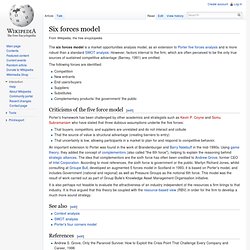
However, factors internal to the firm, which are often perceived to be the only true sources of sustained competitive advantage (Barney, 1991) are omitted. The following forces are identified: CompetitionNew entrantsEnd users/buyersSuppliersSubstitutesComplementary products/ the government/ the public. Cognitive Process Profile. Agile software development. Agile software development is a set of principles for software development in which requirements and solutions evolve through collaboration between self-organizing,[1] cross-functional teams.
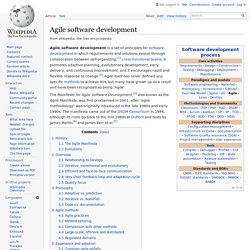
It promotes adaptive planning, evolutionary development, early delivery, and continuous improvement, and it encourages rapid and flexible response to change.[2] Agile itself has never defined any specific methods to achieve this, but many have grown up as a result and have been recognized as being 'Agile'. The Manifesto for Agile Software Development,[3] also known as the Agile Manifesto, was first proclaimed in 2001, after "agile methodology" was originally introduced in the late 1980s and early 1990s.
The manifesto came out of the DSDM Consortium in 1994, although its roots go back to the mid 1980s at DuPont and texts by James Martin[4] and James Kerr et al.[5] History[edit] Incremental software development methods trace back to 1957.[6] In 1974, E. Systems thinking. Impression of systems thinking about society[1] A system is composed of interrelated parts or components (structures) that cooperate in processes (behavior).
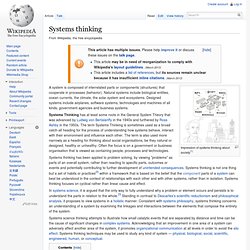
Natural systems include biological entities, ocean currents, the climate, the solar system and ecosystems. Designed systems include airplanes, software systems, technologies and machines of all kinds, government agencies and business systems. Systems Thinking has at least some roots in the General System Theory that was advanced by Ludwig von Bertalanffy in the 1940s and furthered by Ross Ashby in the 1950s. The term Systems Thinking is sometimes used as a broad catch-all heading for the process of understanding how systems behave, interact with their environment and influence each other.
Customer lifetime value. In marketing, customer lifetime value (CLV) (or often CLTV), lifetime customer value (LCV), or user lifetime value (LTV) is a prediction of the net profit attributed to the entire future relationship with a customer.
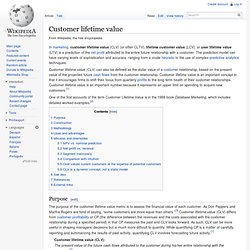
The prediction model can have varying levels of sophistication and accuracy, ranging from a crude heuristic to the use of complex predictive analytics techniques. One of the first accounts of the term Customer Lifetime Value is in the 1988 book Database Marketing, which includes detailed worked examples.[2] Ishikawa diagram. Ishikawa diagrams (also called fishbone diagrams, herringbone diagrams, cause-and-effect diagrams, or Fishikawa) are causal diagrams created by Kaoru Ishikawa (1968) that show the causes of a specific event.[1][2] Common uses of the Ishikawa diagram are product design and quality defect prevention, to identify potential factors causing an overall effect.

Each cause or reason for imperfection is a source of variation. Causes are usually grouped into major categories to identify these sources of variation. The categories typically include: Overview[edit] Ishikawa diagram, in fishbone shape, showing factors of Equipment, Process, People, Materials, Environment and Management, all affecting the overall problem. Six Sigma. The common Six Sigma symbol.
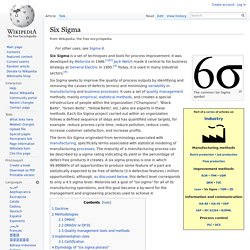
Strategic management. Strategic management involves the formulation and implementation of the major goals and initiatives taken by a company's top management on behalf of owners, based on consideration of resources and an assessment of the internal and external environments in which the organization competes.[1] Strategic management provides overall direction to the enterprise and involves specifying the organization's objectives, developing policies and plans designed to achieve these objectives, and then allocating resources to implement the plans.
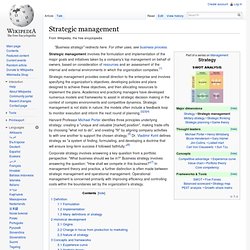
Patent. A patent (/ˈpætənt/ or /ˈpeɪtənt/) is a set of exclusive rights granted by a sovereign state to an inventor or assignee for a limited period of time in exchange for detailed public disclosure of an invention.
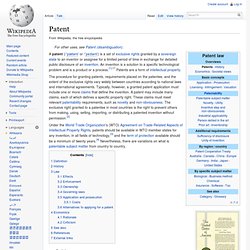
An invention is a solution to a specific technological problem and is a product or a process.[1]:17 Patents are a form of intellectual property. Under the World Trade Organization's (WTO) Agreement on Trade-Related Aspects of Intellectual Property Rights, patents should be available in WTO member states for any invention, in all fields of technology,[3] and the term of protection available should be a minimum of twenty years.[4] Nevertheless, there are variations on what is patentable subject matter from country to country. Definition[edit] The word patent originates from the Latin patere, which means "to lay open" (i.e., to make available for public inspection).
History[edit] U.S. patents granted, 1790–2010.[11] Law[edit] Public Policy. Understanding the need for public and Congressional education about the science of genomics and its implications in solving some very real domestic and global issues led to the establishment of an SGI presence in Washington, DC.
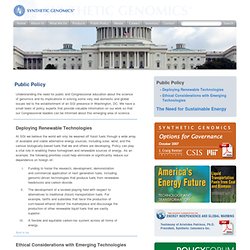
We have a small team of policy experts that provide valuable information on our work so that our Congressional leaders can be informed about this emerging area of science. At SGI we believe the world will only be weaned off fossil fuels through a wide array of available and viable alternative energy sources, including solar, wind, and the various biologically-based fuels that we and others are developing. Policy can play a vital role in enabling these homegrown and renewable sources of energy. As an example, the following priorities could help eliminate or significantly reduce our dependence on foreign oil: While working on the minimal genome/synthetic genome in the mid-1990's Dr.
Desarrollo de aplicaciones Windows* para dispositivos Intel. European Research Forum for Urban Mobility - Transport - Research & Innovation. Background. Business Models on the Web. Business models are perhaps the most discussed and least understood aspect of the web. There is so much talk about how the web changes traditional business models. But there is little clear-cut evidence of exactly what this means. In the most basic sense, a business model is the method of doing business by which a company can sustain itself -- that is, generate revenue.
The business model spells-out how a company makes money by specifying where it is positioned in the value chain. Some models are quite simple.